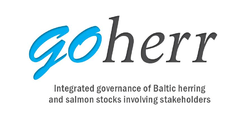Goherr: WP1 Management
Objectives
1) The overall objective of the management of consortium activities is to ensure project implementation according to the description of work
2) To carry out coordinator’s administrative obligations to participants and the BONUS EEIG, and to act as the intermediary between these parties
Description of work
Professor Sakari Kuikka will act as the WP1 leader. He has wide experience in both participating and acting as the Scientific Coordinator in EU funded projects, including the coordination of the BONUS+ project IBAM. A full list of his (and Hoviniemi’s) past and ongoing projects can be found at http://www.helsinki.fi/science/fem/projects.html. Project Coordinator Kirsi-Maaria Hoviniemi will carry the responsibility over the administrative coordination of the project. She will deal with all administrative and financial issues between participants and the BONUS EEIG. In addition to being experienced in administration of EU funded projects, she has substance knowledge on the field of this proposal and will support the timely planning, provision and content of project deliverables.
Task 1.1 Consortium’s communications plan (Month 2 /36)
Drafting and implementing an efficient communications action plan for the consortium. Besides project meetings, this will include regular Skype-meetings and the establishment of a Wiki platform that will serve as the common forum for all participants to transfer knowledge, ideas, results and all sorts of material facilitating the implementation of the project. The plan will be discussed and jointly agreed upon by the consortium at project Kick-off. This Task also includes setting up efficient communications with the BONUS programme.
Task 1.2 Consortium management (M36)
The most important aspect of the management of the consortium activities is to see that the project is implemented according to the project description of work. This will be achieved by ensuring that the work plan is clear and jointly agreed upon, so that each participant is well aware and understands her/his role and obligations, both in the project tasks directly assigned to her/him as well as towards other participants and tasks where input is expected. The project management will ensure that all participants are motivated to carry out their tasks and will produce high quality well-disseminated project deliverables. The coordination of the scientific work will be done in respective work packages where the appointed work package and task leaders have the responsibility over managing the associated tasks and deliverables. The progress of work will be monitored in each project meeting and the management will ensure that corrective actions are taken where needed.
Task 1.3 Scientific and financial reporting (M36)
Coordinating, preparing and compiling the periodic and final reports, and obtaining associated certificates.
Management includes:
A) Administrative coordination between the BONUS EEIG and participants; B) Cooperating with key stakeholder groups, e.g. Baltic Sea Regional Advisory Council (BSRAC) C) Managing of legal, contractual, ethical, financial and administrative aspects of the project. Here, the extensive experience of UH in administration is in a key role; D) Preparing, updating, and managing the Consortium agreements between the participants; E) Coordinating of gender and other issues; F) Ensuring the required communication with relevant advisory and management bodies; G) Obtaining audit certificates from partners whose BONUS funding is equal or more than 750 000, to be submitted with periodic reports; H) Writing and communicating requests for possible amendments to BONUS EEIG; I) Reporting to BONUS EEIG in compliance with the obligations.
In the description of work, each work package, task and deliverable has its named responsible participant. This ensures that the scientist will be motivated to produce work of high quality, while acknowledging the usage of EU scientific funding to develop worldwide sustainability criteria. The planned project meetings are: Kick-off Meeting 1: Month 1, A three day meeting hosted by UH in Finland. The meeting will enable participants to get to know one another and make detailed plans for the implementation of the project work. Participants will be advised on administrative issues. Main Meeting 2: Month 10, A three-day meeting in Denmark, will be organized in collaboration with International Stakeholder Workshop No1. Exchanging first project experiences, updating detailed work plans and schedules, monitoring work progress and preparations for the first periodic reporting. Main Meeting 3: Month 16, three-day meeting in Finland. Main Meeting 4: Month 24, three-day meeting in Sweden. Preparations for the second periodic reporting. Main Meeting 5: Month 29, three-day meeting in Finland, in collaboration with International Stakeholder Workshop No2. Final Meeting: Month 36, in Finland. Preparations for the third periodic reporting.
Deliverables (brief description and month of delivery)
D1.1 Periodic report after 12 months (incl. summary, journal manuscripts, meeting minutes, UH) M14.
D1.2 Periodic report after 24 months (incl. summary, journal manuscripts, meeting minutes, UH) M26.
D1.3 Periodic report after 36 months (incl. summary, journal manuscripts, meeting minutes, UH) M38.
D1.4 Final report (includes a summary and individual journal manuscript versions, UH). M38.
See also
Goherr performance statistics table


